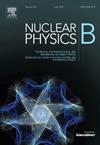存在非酉混合的中微子振荡中的误解
IF 2.8
3区 物理与天体物理
Q2 PHYSICS, PARTICLES & FIELDS
引用次数: 0
摘要
在夸克扇区中,CKM矩阵的一致性偏差被认为是探索标准模型之外的物理的绝佳窗口。在其轻子对应的PMNS矩阵中,这些搜索特别有动力,因为产生中微子质量所需的新物理常常导致标准中微子之间的非幺正混合。因此,考虑在这种情况下如何影响中微子振荡是很有趣的。然而,这个简单的问题有几个微妙之处:定义非酉混合矩阵的振荡概率的正确方法是什么?这些概率加起来等于1吗?非统一的混合矩阵会导致零距离上可观察到的风味转变吗?从中微子振荡得到的统一性约束和从电弱精度数据得到的统一性约束之间有什么相互作用?这项工作旨在阐明这些问题,并澄清文献中常见的相应误解。我们还编制了中微子振荡搜索的更新边界,以与风味和电弱精度观测的边界进行比较。本文章由计算机程序翻译,如有差异,请以英文原文为准。
Misconceptions in neutrino oscillations in presence of non-unitary mixing
Deviations from unitarity of the CKM matrix in the quark sector are considered excellent windows to probe physics beyond the Standard Model. In its leptonic counterpart, the PMNS matrix, these searches are particularly motivated, as the new physics needed to generate neutrino masses often leads to non-unitary mixing among the standard neutrinos. It is then interesting to consider how neutrino oscillations are affected in such scenario. This simple question is, however, subject to several subtleties: What is the correct way to define oscillation probabilities for a non-unitary mixing matrix? Do these probabilities add up to one? Does a non-unitary mixing matrix lead to observable flavor transitions at zero distance? What is the interplay between unitarity constraints obtained from neutrino oscillations and from electroweak precision data? This work aims to shed light on these issues and to clarify the corresponding misconceptions commonly found in the literature. We also compile updated bounds from neutrino oscillation searches to compare with those from flavour and electroweak precision observables.
求助全文
通过发布文献求助,成功后即可免费获取论文全文。
去求助
来源期刊

Nuclear Physics B
物理-物理:粒子与场物理
CiteScore
5.50
自引率
7.10%
发文量
302
审稿时长
1 months
期刊介绍:
Nuclear Physics B focuses on the domain of high energy physics, quantum field theory, statistical systems, and mathematical physics, and includes four main sections: high energy physics - phenomenology, high energy physics - theory, high energy physics - experiment, and quantum field theory, statistical systems, and mathematical physics. The emphasis is on original research papers (Frontiers Articles or Full Length Articles), but Review Articles are also welcome.
 求助内容:
求助内容: 应助结果提醒方式:
应助结果提醒方式:


